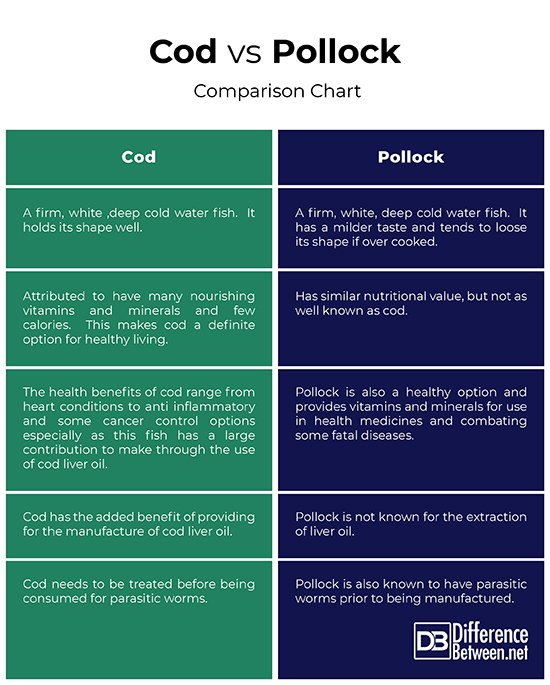Difference Between Cod and Pollock
The Pacific Cod and Alaskan Pollock are both varieties of white, low fat fish. They have a mild taste and can be flaked when cooked. The pollock is softer than cod and will disintegrate if it is over cooked. These fish are often used to make different fish products, like fish fingers and fast foods of breaded or crumbed fish. The Pacific Cod is an excellent fish for all kinds of fish dishes like chowder as it is firm and keeps its shape The pollock on the other hand is softer and suited to being used as imitation crab and in a Californian roll, a sushi dish. Both these types of fish freeze well, but must be cooked because they can be hosts to some parasitic worms. Cod is a cold water fish. It is in danger, in some areas, of being over fished. Pollock has become accessible as a replacement and cheaper alternative to cod,

What is Cod?
Cod belongs to the Gadidae family of fish. They live in salt water, favoring deep cold water temperatures Cod is the best known of this fish family and its flesh is almost white in color. It is usually sold as a filet and has a pleasant buttery taste. It is a spotted fish and can be greenish or grayish in color or sometimes brown and nearly blackish. Occasionally it is a dull to brighter red. The cod has three dorsal fins and two anal fins, as well as a chin barbel. Cod weighs up to 11,5 kgs or 25 pounds. It feeds on other fish and small invertebrates. Cod is also valued for the oil produced from its liver – cod liver oil which is high in healthy omega 3.
What are the nutritional and health benefits of eating Cod?
- Cod is a very healthy fish option containing many vitamins and minerals. It contains vitamin B12, iodine, phosphate, selenium, phosphorus, Vitamin B3 and B6 as well as omega 3 fats
- Nutritionally it is made up of 42% protein. A 4oz piece of fish or 113,4 grams contains 96 calories. Cod has a very low glycemic, GI value.
- Eating cod lowers the risk of heart disease because it is a good source of blood thinning omega 3.
- The omega 3 in rich fish, like cod, lowers the triglycerides in the blood stream. Triglycerides in the correct amounts are a source of energy.
- Cod gives a rich source of omega 3 polyunsaturated fatty acids that help in lowering blood pressure.
- Eating fish, like cod, once a week helps to prevent deep vein thrombosis. This is a dangerous condition where blood clots form in the veins of the legs or pelvis. It has been found that eating fish rich in omega 3 can reduce the risk of deep vein thrombosis to a 30 -45% less chance of this affliction.
- The vitamin B12 and selenium reduce the risk of colon cancer.
- Cod is known to reduce the risk of other cancers like myeloma, non-Hodgkin lymphoma and leukemia. It offers some protection against renal cell carcinoma which is a form of kidney cancer.
- The omegas in cod offer protection against age related cognitive decline like Alzheimer’s. Cod also helps improve mood and reduce depression through the omega 3 content.
- The selenium and omega 3 help relieve inflammation and prevent osteoarthritis and rheumatoid arthritis from progressing further.
- Cod promotes cardio-vascular health because it contains niacin a vitamin B that lowers cholesterol levels. Cod is also known to improve the electrical properties of heart cells. Cod protects the heart against abnormal heart rhythms.
- A high concentration of omega fatty acids are found in the cod liver oil that is produced from the liver of this fish.

What is Pollock?
Pollock is a cold water fish found in the northern oceans of the world. There are a few varieties of pollock. The Atlantic Pollock or Coley, the Alaska Pollock or Walleye and the Norweign Pollock. Pollock has been considered to be a low cost option to cod and it has a milder taste but is still full of nutritious minerals and vitamins. Pollock is a good food choice if you are watching your calories. There are only 92 calories per 100g of pollock fish. Some of the significantly processed fish foods made with pollock may contain harmful additives so it is always wise to read the contents on the packaging of these commercial products. Added to the harmful additives pollock is also susceptible to parasitic worms in its raw state. These worms are similar to the ones found in cod and most fish sellers will have had the worms removed prior to selling the fish. The mild flavor and soft texture of the fish makes it a good substitute for crab meat.
What are the nutritional benefits of eating Pollock?
Pollock has many nutritional advantages. Like cod it is a rich source of vitamins and minerals.
- Pollock contains vitamin B12, B6 riboflavin magnesium, potassium, iron, zinc and copper.
- Pollock is rich in omega 3 fatty acids.
- Pollock can fight heart disease, maintain eye health and regulate blood sugar.
- Pollock increases fertility and improves the development of the fetus.
Differences Between Cod and Pollock.
Characteristics of Cod vs. Pollock:
Both these fish are cold water fish preferring the deeper waters of the oceans they are found in. The pollock is a softer fish and more likely to disintegrate if it is over cooked. The cod and the pollock are used in making manufactured fish goods like fish fingers and crumbed fish pieces, but pollock, with its milder taste is made into imitation crab.
Health benefits:
The health benefits of these two varieties of fish are enormous. Both types of fish have a wide range of vitamins and minerals to enhance a healthy life style. Cod has the added value of the liver oil harvested form its liver and very rich in omega 3 oil.
Nutritional value:
The nutritional and dietary value of these fish is important to note. Cod and pollock contribute many important nutrients and have a long list of health values. They play a part in arresting some cancers and reducing the risk of heart disease and help slow down the cognitive aging process. Eating fish rich in omega and vitamin B is part of a healthy diet and recommended as a weekly intake of omegas and vitamins.
Cuisine:
Cod and pollock are white fish and generally hold their shape. Cod is a firmer fish than pollock. They can both be used successful in many dishes like fish chowder and soups as well as being suitable to bake, fry or broil.
Conservation:
It would appear that there is more of a risk in over fishing for cod than pollock and therefore pollock has become a popular and economical resource for white fish. Both these fish are used commercially and in cuisine.
Cod vs. Pollock: Comparison Chart

Summary of Cod vs. Pollock:
- There are more similarities than differences between cod and pollock.
- Both varieties of fish are renowned for their nutritional values and health benefits.
- The cod and the pollock are low in calories and if eaten regularly help prevent heart conditions and other diseases linked to cancer. It is the omega 3 content that is highly prized as a health supplement.
- Cod and Pollock are used in cooking and in producing commercially manufactured fish products although the milder flavor of pollock makes it a good substitute for crab mat and the sushi dish called California roll.
- Cod keeps its shape better and makes good fish products like fish fingers and battered or crumbed fish portions.
- Cod has become over-fished in some areas and this has led to the commercial use of pollock as a substitute fish.
- It is easy to confuse these two types of fish because they appear similar when cooked. In their raw state both types of fish are susceptible to parasitic worms.
- The essential difference between these tow fish is in their texture.
- Difference Between Lagoon and Bay - October 20, 2021
- Difference Between Futurism and Preterism - August 12, 2021
- Difference Between Dichotomy and Paradox - August 7, 2021
Search DifferenceBetween.net :
Leave a Response
References :
[0]Image credit: https://commons.wikimedia.org/wiki/File:Alaska_pollock_2.jpg
[1]Image credit: https://commons.wikimedia.org/wiki/File:Pacific_cod_-_cropped.jpg
[2]Shaw Hank. 01/28/2019. Pacific Cod and Alaskan Pollock.www.thespruceeats.com.pub Dotdash publishing. Reviewed 9/03/2019
[3]Meikle James 02/04/2013 Fish and chips cod food standard.wwwtheguardian.com/lifeandstyle. Pub the guardian.reviewed. 9/03/2019
